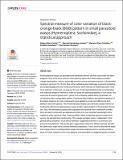Mostrar el registro sencillo del ítem
Spectral measure of color variation of black-orange-black (BOB) pattern in small parasitoid wasps (Hymenoptera: Scelionidae), a statistical approach
| dc.creator | Mora Castro, Rebeca | |
| dc.creator | Hernández Jiménez, Marcela | |
| dc.creator | Alfaro Córdoba, Marcela | |
| dc.creator | Avendaño Soto, Esteban | |
| dc.creator | Hanson Snortun, Paul | |
| dc.date.accessioned | 2020-06-03T15:55:52Z | |
| dc.date.available | 2020-06-03T15:55:52Z | |
| dc.date.issued | 2019 | |
| dc.identifier.citation | https://www.ncbi.nlm.nih.gov/pmc/articles/PMC6812806/pdf/pone.0218061.pdf | |
| dc.identifier.uri | https://hdl.handle.net/10669/81122 | |
| dc.description.abstract | Small parasitoid wasps are abundant and extremely diverse, yet their colors have not been analyzed. One of the more common color patterns observed in these wasps is a black-orange-black pattern, which is especially common among neotropical species of Scelionidae ranging in size from 2 to 10 mm. Due to the methodological challenges involved in extracting and analyzing pigments from small-sized insects, other methods for examining colors need to be explored. In this work, we propose the use of microspectrophotometry in combination with statistical analysis methods in order to 8 study the spectral properties in such cases. We examined 8 scelionid genera and 1 genus from a distantly related family (Evaniidae), all showing the black-orange-black pattern. Functional Data Analysis and statistical analysis of Euclidean distances for color components were applied to study color differences both between and within genera. The Functional Data Analysis proved to be a better method for treating the reflectance data because it gave a better representation of the physical information. Also, the reflectance spectra were separated into spectral color component contributions and each component was labeled according to its own dominant wavelength at the maximum of the spectrum: Red, Green and Blue. When comparing spectral components curves, the spectral blue components of the orange and black colors, independent of the genera being compared, result almost identical, suggesting that there is a common compound for the pigments. The results also suggest that cuticle from different genera, but with the same color might have a similar chemical composition. This is the first time that the black and orange colors in small parasitoid wasps has been analyzed and our results provide a basis for future research on the color patterns of an abundant but neglected group of insects. | es_ES |
| dc.description.sponsorship | Universidad de Costa Rica/[801-B5-A50]/UCR/Costa Rica | es_ES |
| dc.description.sponsorship | Universidad de Costa Rica/[111-B2-A51]/UCR/Costa Rica | es_ES |
| dc.language.iso | en_US | es_ES |
| dc.source | PLOS One, vol.14(10), pp.1-20. | es_ES |
| dc.title | Spectral measure of color variation of black-orange-black (BOB) pattern in small parasitoid wasps (Hymenoptera: Scelionidae), a statistical approach | es_ES |
| dc.type | artículo original | |
| dc.identifier.doi | 10.1371/journal.pone.0218061 | |
| dc.description.procedence | UCR::Vicerrectoría de Investigación::Unidades de Investigación::Ciencias Básicas::Centro de Investigación en Biología Celular y Molecular (CIBCM) | es_ES |
| dc.description.procedence | UCR::Vicerrectoría de Investigación::Unidades de Investigación::Ciencias Básicas::Centro de Investigación en Ciencia e Ingeniería de Materiales (CICIMA) | es_ES |
| dc.description.procedence | UCR::Vicerrectoría de Docencia::Ciencias Básicas::Facultad de Ciencias::Escuela de Biología | es_ES |
| dc.description.procedence | UCR::Vicerrectoría de Docencia::Ciencias Básicas::Facultad de Ciencias::Escuela de Física | es_ES |
| dc.description.procedence | UCR::Vicerrectoría de Investigación::Unidades de Investigación::Ciencias Básicas::Centro de Investigaciones en Matemáticas Puras y Aplicadas (CIMPA) | es_ES |
| dc.description.procedence | UCR::Vicerrectoría de Docencia::Ciencias Sociales::Facultad de Ciencias Económicas::Escuela de Estadística | es_ES |
| dc.identifier.codproyecto | 111-B2-A51 | |
| dc.identifier.codproyecto | 801-B5-A50 |
Ficheros en el ítem
Este ítem aparece en la(s) siguiente(s) colección(ones)
-
Biología [1635]


